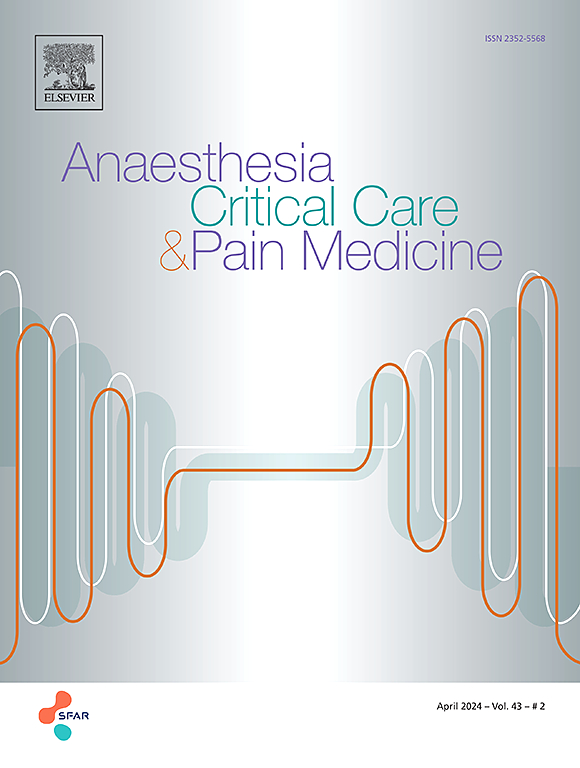在1520例入院的单中心回顾性研究中,在到达儿科烧伤ICU之前插管的儿童早期拔管。
IF 3.7
3区 医学
Q1 ANESTHESIOLOGY
引用次数: 0
摘要
背景:在成人烧伤重症监护病房,超过30%的插管患者在2天内拔管(可能不必要的插管,PUNI)。在儿科人群中缺乏此类数据。本研究的主要目的是探讨儿童PUNI发生率。方法:回顾性分析我院儿科烧伤重症监护病房8年来收治的所有数据。在插管到达的患者中,前两天内拔管被评估为主要结局(PUNI率)。使用单变量逻辑回归和多变量模型,我们分析了与插管持续超过2天(潜在必要插管,PNI)相关的因素。最后,我们开发了一个分数来预测PNI的概率。结果:1520例入院儿童中,年龄0 ~ 17岁;总体表面积百分比(%TBSA): 1- 97%, 56例(4%)插管到达,其中20例(36%)被认为是PUNI。与PNI患者相比,这些患者的TBSA烧伤百分比较小(24±17% vs 48±24%,p = 0.002)。我们根据与PNI独立相关的因素制定了一个评分:TBSA烧伤百分比(每增加1%,OR = 1.12[1.09-1.15]),火焰烧伤(OR = 4.43[1.64-11.6])和面部烧伤(OR = 12.28[3.41-67.4])。结论:儿童在进入烧伤重症监护病房前插管的情况较少。然而,儿童的PUNI发生率与成人报告的结果接近:大约三分之一的插管儿童在2天内拔管。本文章由计算机程序翻译,如有差异,请以英文原文为准。
Early extubations in children intubated prior to arrival in Paediatric Burn ICU: A single center retrospective study over 1520 admissions
Background
In adult burns intensive care units, more than 30% of patients arriving intubated, are extubated within 2 days (potentially unnecessary intubation, PUNI). Such data are lacking in paediatric populations. Exploring this paediatric PUNI rate was the primary aim of the study.
Methods
Data from all the admissions to our paediatric burn intensive care unit were retrospectively analyzed over an 8-years period. Extubations within the first two days among patients arriving intubated were assessed as the primary outcome (PUNI rate). Using a univariate logistic regression and a multivariate model, we analyzed factors associated with intubation lasting more than 2 days (potentially necessary intubation, PNI). Finally, we developed a score to predict the probability of PNI.
Results
Among the 1520 admitted children (age: 0–17; Percentage of Total Body Surface Area (%TBSA): 1%–97%), 56 (4%) arrived intubated, 20 (36%) of whom were considered PUNI. These patients had smaller %TBSA burned compared to those having PNI (24% ± 17% vs. 48% ± 24%, p = 0.002). We developed a score based on factors independently associated with PNI: %TBSA burned (OR = 1.12 [1.09–1.15] for each additional per cent), flame burns (OR = 4.43 [1.64–11.6]) and facial burns (OR = 12.28 [3.41–67.4]). Seven children (<0.5%) were intubated after admission.
Conclusion
Intubation before admission to a burn intensive care unit was less frequent in children. The paediatric rate of PUNI, however, was close to findings reported in adults: approximately one-third of intubated children were extubated within 2 days.
求助全文
通过发布文献求助,成功后即可免费获取论文全文。
去求助
来源期刊

Anaesthesia Critical Care & Pain Medicine
ANESTHESIOLOGY-
CiteScore
6.70
自引率
5.50%
发文量
150
审稿时长
18 days
期刊介绍:
Anaesthesia, Critical Care & Pain Medicine (formerly Annales Françaises d''Anesthésie et de Réanimation) publishes in English the highest quality original material, both scientific and clinical, on all aspects of anaesthesia, critical care & pain medicine.
 求助内容:
求助内容: 应助结果提醒方式:
应助结果提醒方式:


